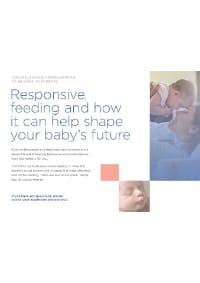Overview
As part of the baby friendly initiative, healthcare professionals (HCPs) have a responsibility to support parents and carers to engage in responsive feeding for breastfed and formula-fed infants.1 Responsive feeding has been shown to be protective against obesity in children later in life.2 This article explores overfeeding a baby and its effects, recognising hunger cues and the importance of responsive feeding.
What is overfeeding?
Obesity in children has been attributed to factors that occur during the first 1000 days of life, which spans from conception to 2 years of age. These include, maternal nutrition, genetic predisposition, breastfeeding and introduction to solids.2 Feeding in infancy (<6 months of age) is thought to be a prime time for appetite and satiety regulation as it occurs during a period of biological malleability which can determine long-term eating habits, growth parameters and future metabolic responses.3 It has been shown that breastfed babies self-regulate their intake in a more efficient way than bottle-fed babies.2
It has been suggested that feeding infants on a three hourly schedule instead of when they show hunger cues, may have a role in the development of obesity in later life by impairing an infant’s response to fullness cues.4,5
One randomised clinical trial provided education to parents which included recognising hunger and satiety cues, feeding in response to hunger and not as an emotional response and age-appropriate portion sizes. The study demonstrated that providing parents with responsive feeding support, reduced rapid infant weight gain, reduced prevalence of overweight infants (at age one year) and improved adherence to dietary guidelines post transition to solid food.6 The intervention benefited both breastfed and formula-fed infants.
The importance of responsive feeding
Responsive breastfeeding recognises that feeds do not simply provide nutrition, but also offers love, comfort and reassurance between a mother and her baby.7 Responsive breastfeeding has multiple benefits including satisfying hunger and providing reassurance for a distressed baby. Therefore, breastfeeding may vary in frequency and length, depending on the needs of the mother and baby. Parents should be reassured that breastfed babies cannot be ’overfed’ or ’spoilt’ by frequent breastfeeding.7
It is possible to practice responsive feeding when formula-feeding, however it is important to acknowledge the risks of overfeeding.7 A systematic review found a positive relationship exists between ‘indulgent feeding’ and overweight/obesity in children and infants. A proposed explanation for these associations, particularly during early years, is parents’ use of feeding as a strategy to calm their child’s behaviour.8 Parents should be supported to identify their baby’s hunger and fullness cues and how to effectively feed whilst keeping their babies close to promote bonding.9 The following strategies can help implement responsive feeding in formula-fed infants:7,9
- Offer the bottle in response to hunger cues.
- Gently invite the baby to accept the teat.
- Practice paced bottle feeding.
- Avoid forcing the baby to finish the feed.
- Practice bonding with the baby through eye and skin-to-skin contact.
- In the first few weeks, try to minimise the number of people regularly feeding the baby to help strengthen the bond between baby and parent.
Responsive feeding helps to promote attentiveness to internal cues of hunger and satiety and successful progression to independent feeding throughout childhood.10
Importance of recognising hunger and fullness cues for responsive feeding
There still remains the common belief amongst HCPs that a ‘normal’ feeding pattern is to feed every three hours. However, to effectively practice responsive feeding, it is important that parents are taught how to recognise the signs babies use to communicate their hunger and fullness. This is particularly important in formula-fed babies to help prevent overfeeding.
Parents of formula-fed babies should be reassured that there are other effective methods to calm and soothe babies in the absence of breastfeeding (e.g., cuddling and skin-to-skin contact) which will continue to strengthen the parent-infant attachment.7
Summary
When supporting parents with infant feeding, HCPs should engage in respectful discussions with regard to feeding. Clinical evidence supports the practice of responsive feeding in both breastfed and formula-fed infants.

Download the factsheet



